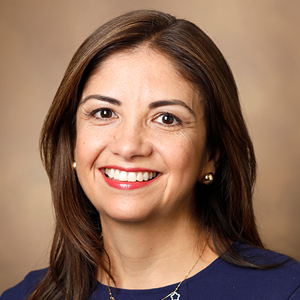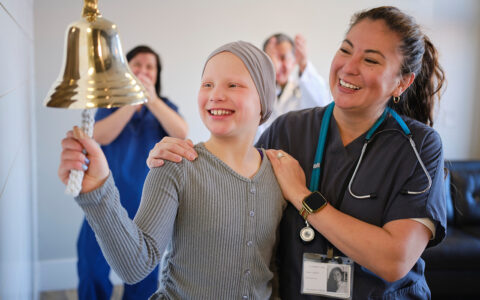Thyroid cancer is the most common endocrine cancer in the pediatric population, representing approximately 2 to 4 percent of all pediatric malignancies.
Monica E. Lopez, M.D., a pediatric surgeon at Monroe Carell Jr. Children’s Hospital at Vanderbilt, provides care to children with thyroid cancer. Lopez also conducts research to improve the clinical care of pediatric patients with thyroid cancer along with her colleague, Sara Duffus, M.D., assistant professor of pediatrics and pediatric endocrinology at Vanderbilt University Medical Center.
The American Thyroid Association (ATA) published guidelines for children with thyroid nodules and differentiated thyroid cancer in 2015. Previously, treatment recommendations for children were extrapolated from the ATA’s adult guidelines.
Over the past decade, however, it has become increasingly clear that pediatric thyroid cancer contains several distinctions from the adult pathology, including clinical, molecular and pathological differences. In a recent review, Lopez and Duffus discuss the evolving landscape of pediatric thyroid cancer and highlight the need for updated guidelines.
“The biggest unmet need in pediatric thyroid cancer today is delivery and access to multidisciplinary care,” Lopez said. “For a child with a thyroid surgical problem, this comprehensive care extends beyond an operation and requires highly skilled team members devoted to the specialty of pediatric endocrine disorders.”
Nodule Classification Systems
Historically, guidelines for treating thyroid nodules have been tailored to adults due to a lower prevalence of thyroid cancer in children. Given the increased rates of malignancy and more aggressive features in pediatric compared to adult thyroid nodules, experts have advised caution in applying adult nodule classification systems to the pediatric population.
The two primary nodule classification systems are the 2015 ATA Management Guidelines for Adult Patients with Thyroid Nodules and Differentiated Thyroid Cancer and the American College of Radiology Thyroid Imaging Reporting and Data System.
The 2015 ATA Adult Thyroid Nodule and differentiated thyroid cancer guidelines provide an atlas of nodule sonographic patterns with associated risk of malignancy. The imaging features also are also combined with nodule size to guide fine-needle aspiration decision-making.
However, using size criteria for pediatric thyroid nodules can be challenging due to differing thyroid volume by age, the researchers explained. Since a nodule’s size alone does not predict the likelihood of malignant histology in children, the 2015 pediatric guidelines recommend evaluation using ultrasound characteristics and clinical context, alongside the typical pattern-based system.
“This is one example of the importance of adapting guidelines to the pediatric population,” Duffus said, adding that more research is needed to determine how to apply and potentially modify nodule classification systems for the pediatric population to optimize the diagnostic workup.
The Next Frontier: Molecular Genetics
Research suggests that the genetic landscape of pediatric thyroid cancer is distinct from adult thyroid cancer. Onogenic gene fusions occur with greater frequency in the pediatric population (50 to 60 percent in children compared to 15 percent in adults), and point mutations are less prevalent, found in 30 percent of pediatric thyroid cancers compared to 70 percent of adults.
The use of molecular testing has radically transformed diagnostic algorithms in adults with cytologically indeterminate thyroid nodules. Recent evidence from investigators at Vanderbilt suggests that next-generation sequencing testing can discriminate benign from malignant nodules in children, which may reduce the need for diagnostic surgery.
“The field of molecular testing in pediatric thyroid cancer continues to evolve and demonstrates how it can be helpful in specific clinical applications,” Lopez said. “For example, many reports are now published on how targeted therapies can be offered to pediatric patients with refractory, metastatic and/or radioiodine-resistant tumors to achieve a positive response.”
Duffus added: “Our ability to sequence pediatric patients’ tumors and understand the oncogenes underlying these cancers is where the field is moving next.”
While genetic testing is becoming increasingly paramount to the management of pediatric patients with thyroid cancer, several ongoing studies, including the NCI-COG Pediatric MATCH (Molecular Analysis for Therapy Choice) Trial, will continue to advance the field of precision medicine and, ultimately, improve the care of children with thyroid cancer.







